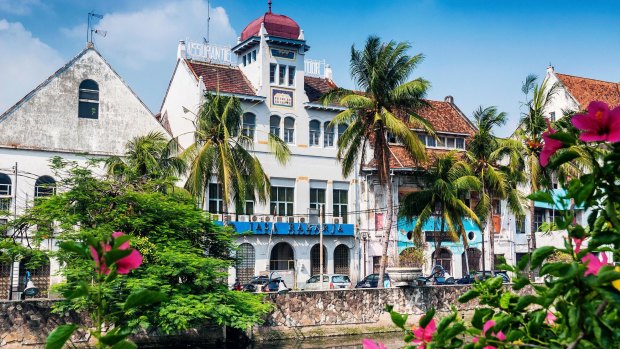This was published 4 years ago
Batavia: The place that helped shape Australia. But where is it?

Dutch colonial buildings in Jakarta's old town.Credit: Jack Malipan Travel Photography / Alamy Stock Photo
On a sunny Friday afternoon, in the historical heart of Jakarta, one of the world's most crowded and traffic-polluted cities, a beautiful UNESCO-listed colonial square echoes to the hubbub of laughing children.
Some ride bicycles. Others pose for photographs with performance artists impersonating Indonesian heroic and mythical characters. Yet the elegant architecture bears greater resemblance to 17th-century Europe than anything native to south-east Asia.
This is Batavia, the most important outpost of the Dutch East Indies Company – or VOC to the Dutch – one of the most ruthless and wealthiest monopolies in the history of global business.
Founded in 1619, Batavia was the capital of the VOC's lucrative spice trade for 3½ centuries. Ships laden with tamarind, mace, cloves and nutmeg – once worth more, gram for gram, than gold – set sail from here to the Netherlands.
"The wealth of Amsterdam and the painting commissions of Rembrandt and other Dutch old masters which hang in art galleries around the world was built in my country," says Iwan, my guide. "Here in Batavia."
Few Australians today have heard of Batavia. Fewer still realise it is one of Jakarta's secret jewels, superbly restored to World Heritage status – largely with Dutch money. Yet here it is: an island of tranquility in the tumultuous ocean that is Indonesia's unplanned modern capital with its population of 10 million-plus.
The president, Joko Widodo, hopes to move Indonesia's seat of government to somewhere less crowded. But Batavia will always be the original capital. It was only renamed Jakarta in 1949 when the former colony won its independence.
After sharing a cheap lunch of nasi rendang and Bintang beer at Historia, a converted spice warehouse in the area known as Jakarta Kota, we emerge into a scene that seems positively Disneyesque.
Iwan points out the still-legible Dutch names adorning the main buildings, but his purpose is to expose the horror behind the veneer of colonial "civilisation".
"See that sunken fountain in the middle of the square? It was lost for many years," he says, explaining it was the scene of a particularly cruel VOC form of punishment known as "the water jail".
Up to 50 offenders were handcuffed to the sunken fountain, standing 24 hours a day because they would drown otherwise in thigh-deep water. Likewise, what is now the Jakarta History Museum used to be Batavia's city hall, or Stadhuis.
Built in 1710, its impeccably restored facade masks what were filthy dungeons and torture chambers. What does this have to do with Australia? Batavia has played a surprisingly significant role in our history.
After his near shipwreck on the Great Barrier Reef, James Cook nursed the Endeavour into Batavia in 1770. Had he not reached here, been able to sail the repaired Endeavour back to Georgian Britain and report his discovery of Botany Bay, who knows where the First Fleet would have ended up?Two decades later, William Bligh arrived in Batavia after an epic 6500-kilometre voyage in a long boat to report HMS Bounty had witnessed the most cinematic naval mutiny in history. The port also gave its name to an ill-fated VOC flagship. On its maiden voyage the Batavia was shipwrecked in June 1629 on Houtman Abrolhos, way west of WA.
That led to what still remains the worst recorded instance of mass murder on Australian soil, an opera and a library of books. As we walk north past the square, more signs of the Dutch colonial era reveal themselves. There's the short stretch of tracks which commemorate the tram system that existed before Jakarta fell foul of the combustion engine, plus a row of teetering, tall, skinny canal-side houses looking the mirror image of buildings you'll see in modern Amsterdam. Iwan insists we explore Sunda Kelapa, the old harbour district, passing by Jakarta's last remaining Dutch-style canal bridge – "chicken bridges" in Indonesian – immortalised in the paintings of Rembrandt and Van Gogh.
Our final stop is the new maritime museum, created out of Dutch-era warehouses. It's a fitting finale to a day spent exploring a single thread in Indonesia's rich fabric.
TRIP NOTES
FLY
Qantas and Garuda Indonesia have direct flights to Jakarta. See qantas.com; garuda-indonesia.com
MORE
Sign up for the Traveller Deals newsletter
Get exclusive travel deals delivered straight to your inbox. Sign up now.